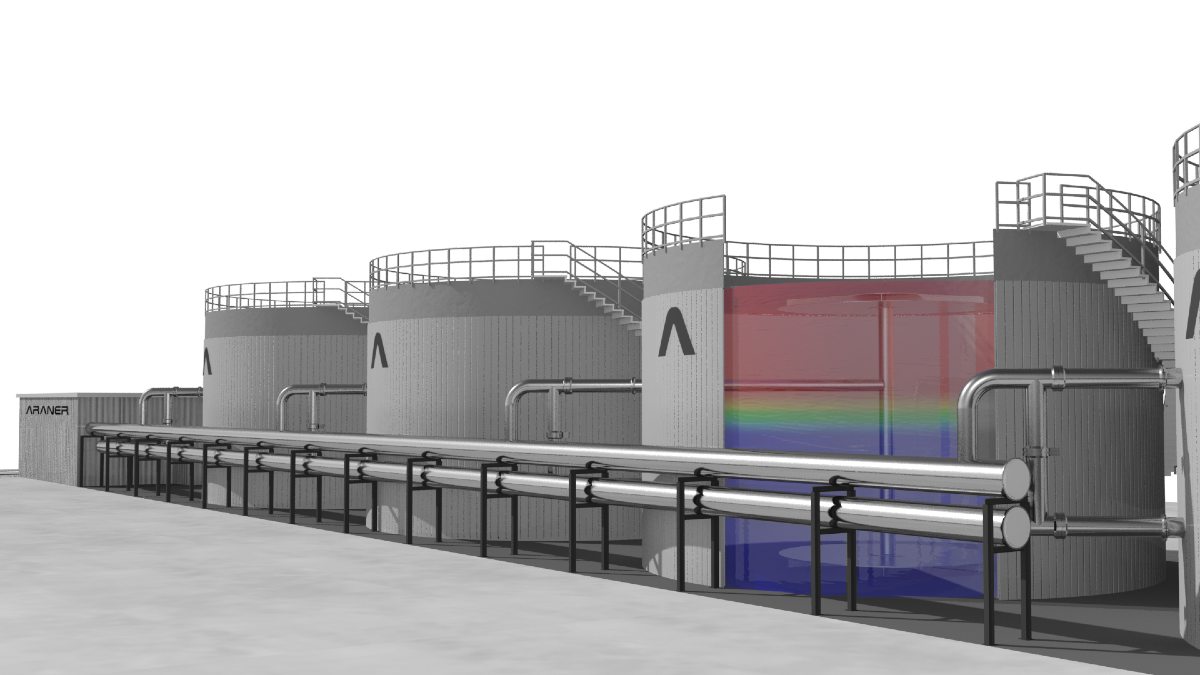Thermal Energy Storage (TES) systems are accumulators that store the excess of production to be used during periods of high thermal energy needs. Thus, TES Tanks are a great option to generate big energy savings among other benefits that may bring to your plant.
When no TES is installed, the thermal energy produced by the plant has to be adapted to the energy demand fluctuation at every moment. This causes big differences between the working conditions of the plant for two different points of the same day.
The integration of the TES provides flexibility and the plant will be able to operate under constant conditions independently of the energy demand. As shown in Figure 1, when the constant capacity of the chillers is higher than the cooling demand, the TES tank will be charged. When the demand is higher than the capacity of the chillers, the remaining requested capacity will be delivered from the TES system
In this line, when the integration of a TES system is considered during the plant planning and design stages, the plant does not need to be designed for the peak demand, but for the average demand. This reduces the required capacity, with the consequent reduction of the footprint and capital cost.
Cost savings thanks to TES Systems
Taking into account the cost of energy and the different tariffs, in those countries with a fixed rate electricity tariff, the reduction of the electricity consumption can be achieved by reducing the number of chillers and the rest of the thermal energy demand will be satisfied from the TES system, resulting not only in energy savings, but also in a reduction in energy costs.
In contrast, in those regions with variable rate electricity tariff, the use of a TES system allows to optimize the operating strategy by shifting the periods of cooling generation to electricity low-cost periods. Consequently, independently of the electricity tariff (fixed or variable rate), the use of thermal energy storage systems reduces the annual energy consumption and the operational costs.
Main advantages of implementing TES Systems
From the operational perspective, the implementation of a TES system provides, among other, two following main advantages:

- TES system provides redundancy in case of failure of the cooling generation system. This is particularly important in mission critical applications, such as data centers.
- TES system can also represent a back-up to meet any future increase in the cooling demand in short-medium terms.
With respect to regulations, many governmental authorities have already implemented state-mandated requirements to install Thermal Storage technologies. For instance:
- As per Dubai Green Building Regulations & Specifications [2], all new district cooling plants must incorporate a Thermal Energy Storage facility with a capacity of, at least, twenty percent of the design capacity of the plant.
- As per Qatar DC Design & Water Management Code [3], all new plants with capacity equal to or greater than 10,000 TR shall include a TES system.
- As per Kuwait Energy Conservation Program [4], the use of cool storage is mandatory for building with plant production capacity of 500 TR and above, and recommended for partially occupied building with plant production capacity of below 500 TR.
Additionally, the Paris Climate Change Agreement has forced governments worldwide to consider more sustainable TES systems over alternative options.
Why choosing TES Systems besides energy and cost reduction
Therefore, the main benefits of TES systems are summarized as follows:
- Reduce capital cost and significant financial benefits.
- Energy production and storage during electricity low-cost periods.
- Reduces annual energy and operational costs.
- Maximize efficiency in water production and consumption.
- Ensure mission critical operations.
References
[1] ASHRAE Design Guide for Cool Thermal Storage, Second Edition, 2019.
[2] Green building regulations & specifications, Government of Dubai.
[3] District Cooling Design & Water Management code, 2016, Kahramaa.
[4] Energy Conservation Program, Code of Practice. Ministry of Electricity & Water, Kuwait.










